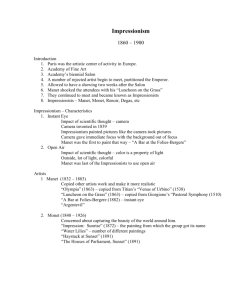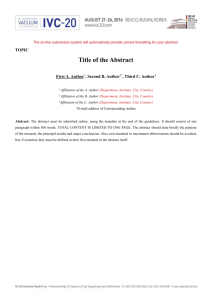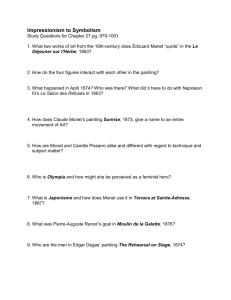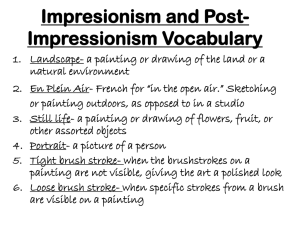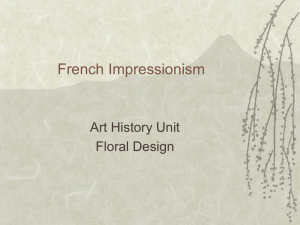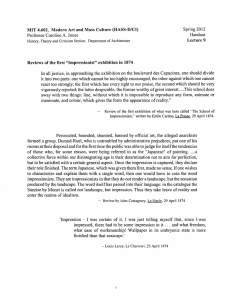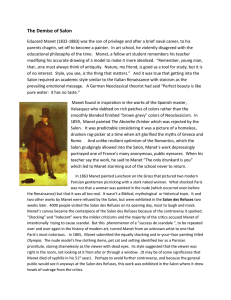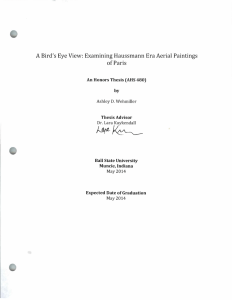Group Formation Power Point
advertisement
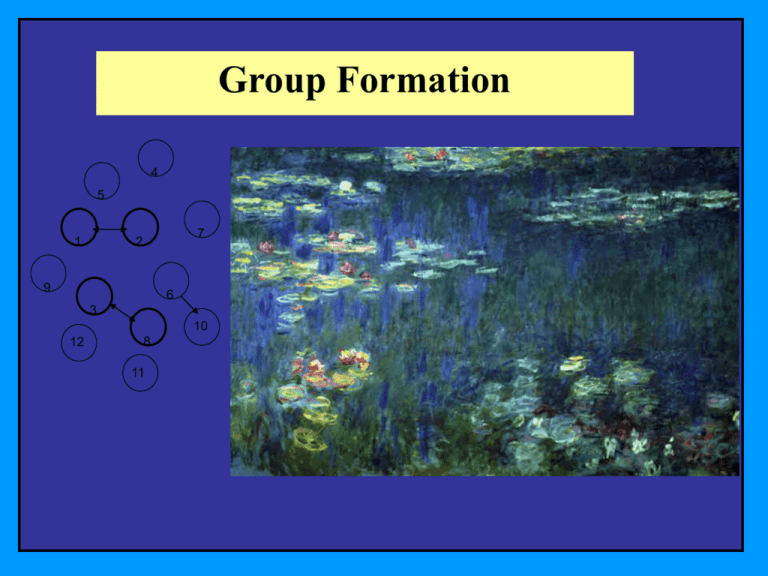
Group Formation 4 5 1 7 2 9 6 3 10 12 8 11 The Impressionists Henri Fantin-Latour’s A Studio at Batignolles featuring Manet (seated), Renoir (framed), Zola, Bazille, and Monet (hidden in the back). Impressionists Renoir Manet Degas Caillebotte Frédéric Bazille Mary Cassatt Gustave Caillebotte Paul Cezanne Edgar Degas Armand Guillaumin Édouard Manet Claude Monet Berthe Morisot Camille Pissarro Pierre-Auguste Renoir Theodore Robinson Alfred Sisley Vincent Van Gogh Morisot Van Gogh Pissarro Monet Nadar¹s Studio at 35 Boulevard des Capucines, site of the first exhibition Impressionists Frédéric Bazille Mary Cassatt Gustave Caillebotte Paul Cezanne Edgar Degas Armand Guillaumin Édouard Manet Claude Monet Berthe Morisot William McGregor Paxton Camille Pissarro Pierre-Auguste Renoir Theodore Robinson Alfred Sisley What Factors Determine When a Group Will Form? People: joining with others in a group depends on individuals' personal qualities, including traits, social motives, and gender. Situations: some situations prompt people to affiliate with one another, including – Ambiguous, dangerous situations – Tasks and goals that can only be achieved by collaborating with others Relationships: groups form when individuals find they like one another. Who Joins Groups and Who Remains Apart? Personality – Introversion-extraversion: extraverts are drawn to other people and groups and introverts avoid them (extraverts tend to be happier individuals) – Relationality: individuals who adopt values, attitudes, and outlooks that emphasize and facilitate connections with others seek out group memberships Who Joins Groups and Who Remains Apart? Social motivation – – – – Need for affiliation Need for intimacy Need for power Fundamental Interpersonal Relations Orientation (FIRO) theory: Individuals’ need to receive and express inclusion, control, and affection influences group-seeking tendencies Who Joins Groups and Who Remains Apart? Prior experiences in groups Attachment style – Secure – Avoidant – Anxious Sex differences in joining groups When and Why Do People Seek Out Others? Affiliation and social comparison Ambiguous, confusing circumstances Psychological reaction Negative emotions Uncertainty Need for information Affiliation and social comparison with others Cognitiv e Clarity Social comparison: gaining information from other people’s reactions (Festinger, 1954) When and Why Do People Seek Out Others? Schachter’s studies of affiliation – How do people react in an ambiguous, frightening situation? • Misery loves company: People affiliate with others • Misery loves miserable company: Schachter found people prefer to wait with others facing a similar experience. When and Why Do People Seek Out Others? Schachter’s studies of affiliation (cont.) – Directional comparison: • downward social comparison: bolsters sense of competence • upward social comparison: hope and motivation – The self-evaluation maintenance (SEM) model: people affiliate with individuals who do not outperform them in areas that are very relevant to their self-esteem. When and Why Do People Seek Out Others? Social support – Safety in numbers • "fight-or-flight" • "tend-and-befriend“ – Types of social support: approval, emotional, informational, instrumental, spiritual Fight vs. Flight and Groups When and Why Do People Seek Out Others? Collaboration – Groups form when individuals seek goals that they cannot attain working alone. • How difficult is the task? • How complex is the task? • How important is the task? – Example: Gangs as a means to achieve goals Use drugs Family member belongs Impress girls Buy drugs Nothing to do Impress friends Impress neighborhood My neighborhood Defend Neighborhood Make money Sell drugs Protection 0 20 40 60 80 100 When Do Processes of Interpersonal Attraction Between Individuals Contribute to Group Formation? Newcomb: The acquaintance process Principles of attraction – proximity principle: People tend to like those who are situated near by. – elaboration principle: Groups often emerge when groups, as complex system, grow as additional elements (people) become linked to original members. – similarity principle: People like those who are similar to them in some way. • homophily: similarity in attitudes, values, appearance, etc. When Do Processes of Interpersonal Attraction Between Individuals Contribute to Group Formation? – complementarity principle: People like others whose qualities complement their own qualities. – reciprocity principle: Liking tends to be mutual – minimax principle: Individuals are attracted to groups that offer them maximum rewards and minimal costs. When Do Processes of Interpersonal Attraction Between Individuals Contribute to Group Formation? Social exchange theory – Relationships are like economic exchanges, bargains where maximum outcomes sought with minimum investment – Satisfaction is determined by comparison level (CL) – Value of other groups determines comparison level for alternatives (CLalt)
